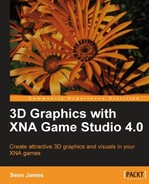Book Description
A step-by-step guide to adding the 3D graphics effects used by professionals to your XNA games.
Improve the appearance of your games by implementing the same techniques used by professionals in the game industry
Learn the fundamentals of 3D graphics, including common 3D math and the graphics pipeline
Create an extensible system to draw 3D models and other effects, and learn the skills to create your own effects and animate them
In Detail
XNA is a very powerful API using which it's easy to make great games, especially when you have dazzling 3D effects. This book will put you on course to implement the same 3D graphics used in professional games to make your games shine, and get those gamers addicted! If you think 3D graphics is something that limits your games, then this book is for you.
3D Graphics with XNA Game Studio 4.0 is a step by step companion to implement the effects used in professional 3D games in your XNA games. By the time you're done with this book your games would have eye-catching visuals and 3D effects.
The one thing that can make or break a game is its appearance; players will mostly be attracted to a game if it looks good. With this book you will create your 3D objects and models and make them look more interesting by using shadowing and lighting techniques, and make them move in nasty ways using animation. Want to create realistic terrians for your games? Need some place for your 3D models to engage in battle? This book will enable you to do all that and more, by walking you through the implementation of numerous effects and graphics techniques used in professional games so that you can make them look great.
Table of Contents
- 3D Graphics with XNA Game Studio 4.0
- 3D Graphics with XNA Game Studio 4.0
- Credits
- About the Author
- About the Reviewers
- www.PacktPub.com
- Preface
- 1. Getting Started with 3D
- Setting up a new project
- The 3D coordinate system
- Matrices
- Loading a model
- Drawing a model
- Creating a Custom Model class
- Creating a Camera class
- Calculating bounding spheres for models
- View frustum culling
- Additional camera types: Arc-Ball
- Additional camera types: chase camera
- Example—spaceship simulator
- Summary
- 2. Introduction to HLSL
- 3. Advanced Lighting
- 4. Projection and Shadowing Effects
- 5. Shader Effects
- 6. Billboard and Particle Effects
- 7. Environmental Effects
- 8. Advanced Materials and Post Processing
- 9. Animation
